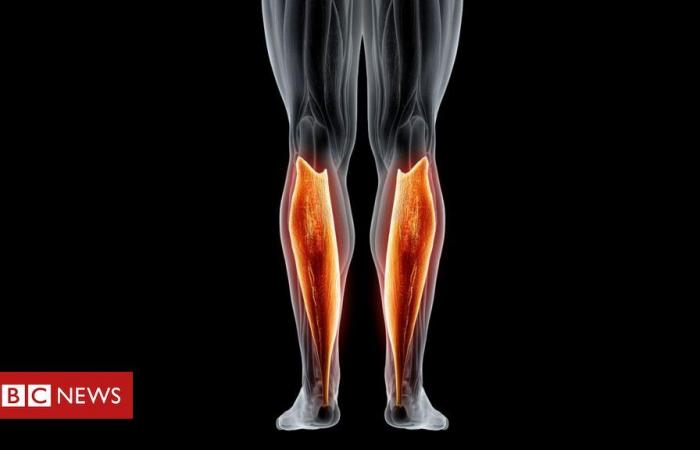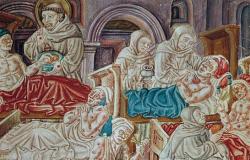It is a muscle little known by people in general, but of great relevance. And not just because it is essential for us to be able to stand and walk.
The soleus, located in the lower part of the calf, is one of those multifaceted organs that not only keeps us upright, but contains two important veins inside that play a key role in blood circulation.
Therefore, it is often called “second heart”.
Part of what makes it special is its composition, as doctor Carles Pedret, a specialist at the Faculty of Sports Medicine at the University of Barcelona, in Spain, explains to BBC News Mundo, the BBC’s Spanish-language news service.
“First of all, it’s very big,” he says.
“He has a lot of muscle mass. And it’s mostly made up of pure muscle tissue, and not as much connective tissue as other muscles,” he adds.
This is related to its function, as you will understand below.
Stability
Credit, Getty Images
“The soleus is essential for any activity performed while standing or walking,” explains doctor Marc Hamilton, from the University of Houston, in the USA, to BBC News Mundo.
Depending on their function, the body’s muscles are made up of different types of fibers.
For the muscles that maintain the body’s structure—like those on the inside of the back, which keep the spine straight—the body uses slow-twitch fibers. These are fibers that, although they are not made to carry out sudden movements, have great resistance and can remain contracted for hours with few symptoms of fatigue.
It’s what allows you to stand or walk for long periods of time.
On the other hand, there are the muscles of the hands, legs and arms, which contain fast-acting fibers — that is, fibers that contract and relax almost instantly to perform the movements we are capable of.
The soleus, as a structural muscle that helps you stay upright, has a large composition of slow-twitch tissue, which makes it capable of generating large amounts of energy without becoming as fatigued.
“The soleus has a large amount of muscle fiber, and the muscle fiber has an element that is fundamental for energy generation, mitochondria. Due to the large number of mitochondria, we see that when we stimulate it, it generates a large amount of energy”, explains Pedret.
It is this density of fibers that makes this muscle, which represents just 1% of body weight, have a much greater energy capacity than many other organs in the body.
A pumping system
Credit, Getty Images
The soleus also has a very particular function: it assists the heart in its work of pumping blood around the body.
“The anatomy of the soleus is different from that of other muscles”, says Hámilton to BBC News Mundo.
“Inside your calves, there are some big veins that are inside your soleus, and those veins are there for a good reason.”
“If you think about it, gravity is causing blood to pool in your calves, ankles and feet. It’s a problem that affects adults, but even young people.”
“However, wise nature placed these veins within the soleus so that they compress when the muscle contracts. When you compress them, these veins fill and empty, and send this fluid back to the heart,” he explains.
Basically, with every step you take, you are pushing the blood in your legs back to your heart. This system, which also includes several veins of the foot and the gastrocnemius muscle, is known as the popliteal pump.
Good maintenance
Like all muscles in the body, the soleus needs to work to stay healthy. But, unlike the activities that we subject fast fiber muscles to, the work of the soleus must be slower and constant.
For Pedret, the ideal is to walk:
“Everyone’s tendency is to believe that by strengthening and exercising the soleus muscle a lot, it will be healthier. And, precisely because of its characteristics, this muscle needs something that is kind of the opposite of all of this. In other words, what he needs is sustained activity, but without stressing him too much.”
“So what he needs is simply to work. You can’t leave him standing still. Rest and a sedentary lifestyle are very bad for him, just as excessive exposure to strength exercise also affects him.”
It is the golden rule when it comes to our muscles, which scientists increasingly relate to the general good functioning of our body.
“What I always say is that people tend to attribute a good quality of life in old age to good mental health, and that is completely true, but the best quality of life is provided by good muscle tone,” says Pedret.
“In other words, constantly working your muscles offers a wide variety of benefits for the correct maintenance of the body.”
“Maintaining good muscle activity and good muscle tone makes the entire metabolic system work better. It decreases the risk of disease. The brain also works better, so there is also less risk of dementia, i.e. the quality of health mentality improves.”
Tags: Soleus muscle importance heart
--





